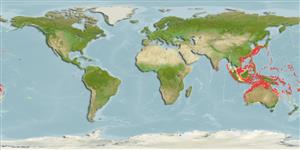>
Perciformes/Scorpaenoidei (Scorpionfishes) >
Scorpaenidae (Scorpionfishes or rockfishes) > Pteroinae
Etymology: Pterois: Greek, pteron = wing, fin (Ref. 45335); paucispinula: Name from Latin which means 'few spines'; referring to the small number of spinules on the head and body ctenoid scales.
Environment: milieu / climate zone / depth range / distribution range
Ecologia
marino associati a barriera corallina; distribuzione batimetrica 1 - 440 m (Ref. 101439). Tropical (Ref. 114776)
Distribuzione
Stati | Aree FAO | Ecosystems | Presenze | Point map | Introduzioni | Faunafri
Indo-West Pacific: from India to northern Australia (Timor Sea); north to southern Japan; eastwards to Wallis and Futuna Islands.
Size / Peso / Age
Maturity: Lm ? range ? - ? cm
Max length : 14.4 cm SL maschio/sesso non determinato; (Ref. 101439)
Short description
Chiavi di identificazione | Morfologia | Morfometria
Spine dorsali (totale) : 8; Raggi dorsali molli (totale) : 10 - 11; Spine anali: 3; Raggi anali molli: 6. This species is distinguished from its congeners by the following combination of characters: D XIII, 10 (rarely XIII, 11); pectoral-fin rays 17-19 (modally 18); scales below lateral line 11-15 (13); body depth at anal-fin origin 26.0-32.8 (mean 30.2) % SL; head width 12.6-15.6 (14.4) % SL; postorbital length 15.4-20.0 (18.1) % SL; longest dorsal-fin spine length 42.9-51.7 (47.8) % SL; caudal-peduncle depth 9.9-11.9 (11.0) % SL; pectoral fin with 14-28 relatively large (subequal to pupil diameter) black blotches on membrane, several bands on the posterior portion of rays (not attached to membrane); several narrow to wide vertical bands laterally on body and caudal peduncle; the area of ctenoid scales on body is relatively small (usually dorsolateral region only at ca. 90 mm SL, sometimes extending below lateral line onto ventrolateral region, and on pectoral-fin base and laterally on caudal peduncle in adults greater than 80 mm SL (Ref. 101439).
Life cycle and mating behavior
Maturità | Riproduzione | Deposizione | Uova | Fecundity | Larve
Matsunuma, M. and H. Motomura, 2015. Pterois paucispinula, a new species of lionfish (Scorpaenidae: Pteroinae) from the western Pacific Ocean. Ichthyol. Res. 62(3):327-346. (Ref. 101439)
IUCN Red List Status (Ref. 130435: Version 2024-1)
Threat to humans
Harmless
Human uses
Pesca: di potenziale interesse
Strumenti
Special reports
Download XML
Fonti Internet
Estimates based on models
Phylogenetic diversity index (Ref.
82804): PD
50 = 0.5005 [Uniqueness, from 0.5 = low to 2.0 = high].
Bayesian length-weight: a=0.01000 (0.00440 - 0.02274), b=3.02 (2.83 - 3.21), in cm total length, based on LWR estimates for this (Sub)family-body shape (Ref.
93245).
Trophic level (Ref.
69278): 3.8 ±0.6 se; based on size and trophs of closest relatives
Resilienza (Ref.
120179): Medio, tempo minimo di raddoppiamento della popolazione 1.4 - 4.4 anni (Preliminary K or Fecundity.).
Fishing Vulnerability (Ref.
59153): Low vulnerability (10 of 100).
